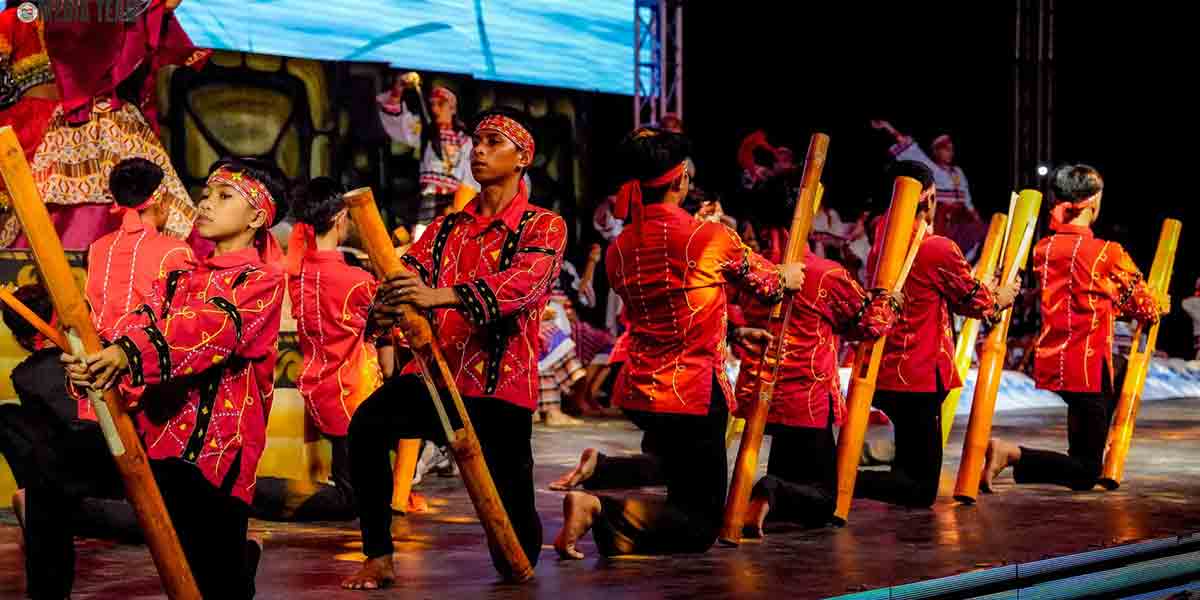By Noel Galon de Leon, UP Visayas
I was invited as a speaker at Pasinaya 2024 by the Cultural Center of the Philippines at the Iloilo Museum of Contemporary Art (ILOMOCA) here in Iloilo last February 3, 2024 to talk about the writing of folk poetry of the people of Panay, specifically the luwa.
I only have 30 minutes allotted for my lecture because there are many lined up next lectures and performances throughout the duration of Pasinaya 2024. Before I begin, I noticed that the audience seems excited about what I’m going to say about luwa. Some of them seem familiar with this folk literature, but the young attendees might just be curious about the title of my lecture, “Bálay Binaláybay Starter Pack” which is probably why they entered my session.
I started by explaining why it is important for us as Panayon writers to know our tradition of writing. Aside from being forgotten by today’s younger generation, many of them misunderstand its meaning. I mentioned that my lecture could branch out to other topics related to folk literature such as komposo, banggianay, paktakun, and pagdayaw. But because of the limited time allocated to me, the focus of my discussion will only be centered on luwa.
Here are some excerpts from the paper I read during the lecture:
When our literature, particularly the folk literature of Panay, is being discussed, I used to feel offended. I don’t know, but ever since I was in college and started to become interested in reading and studying local literature, I’ve come across so many binaláybay that are just plain offensive.
And of course, growing up in the religious upbringing of the Hijas de Jesus sisters in Guimaras, attending novena every Wednesday, memorizing the holy rosary, I was really shaken to the core, and I felt like my religious conviction, which had been communicated and asserted by the beloved sisters I grew up with for many years, was being insulted because of what I read about our own literature.
Here’s the thing, when I was in college, my parents enrolled me in a Catholic school run by Augustinian priests. Maybe they thought I fit in well with that university because I was a modest child who loved to pray, had no vices, and studied hard – that’s what they knew.
I was a scholar back then because I was a member of the university’s student paper, and I didn’t have to pay tuition fees, so I had the confidence to ask for extra allowance for buying books and photocopying materials.
I used to hang out a lot in the archiving section of our library, because some old published Filipiniana materials were kept there, which my teachers often used as references in our class. When I didn’t have a budget to buy books, I would photocopy my favorite pages from them.
My teachers in Literature, Dramatics, and Filipino were excellent; aside from being dedicated to teaching, many of them were writers and scholars, and some even had their own books. As early as my first year, I had already read several versions of Humadapnon, one of the epics of Panay.
We also had great selections of readings in our literature classes. I got to know Flavio Zaragoza Cano, Anghel Magahum, Magdalena G. Jalandoni, and in my final years at the university, Ramon Muzones, the first National Artist for Literature who wrote in Hiligaynon, not in Filipino or English, because he dedicated his life to writing in the Hiligaynon language.
One day, while I was thoroughly enjoying reading our literature lesson for a performance, my mom asked me what I was reading and why I was so delighted. I was hesitant to let her read our lesson because I was afraid, she might ask me about it and I wouldn’t have any answers.
But since she insisted, I gave her my notes. She read them and was shocked by what she read. I knew she wasn’t pleased because her face turned red, and her gaze was fixed on me. This is because these are some of what she read:
Sa idalom sang taytay // May army nga napatay // Bulag-bulag ang lawas // P’ro gatindog ang armas.
Didto sa amon sa Ajuy // May nadula nga balinghoy // Duda gid ako sa imo Nonoy // Ara sa imo gataboy-taboy.
Didto sa Guimaras // May tawo nga haras-haras // Ginpitik ko iya itlog // Daw lingganay katunog.
After she finished reading the first three examples, she asked me if this was really what was being taught to us at the university. At the Catholic university where she also graduated from. She said, as far as she could remember, this wasn’t part of their curriculum back then. They were not allowed to read such materials. And because she was really insistent, she continued reading until she couldn’t bear the last example she read, and she finally let go of my notebook, and this was the last thing she read:
Palayo-palayo // Ang buho nga mabaho // Palapit-palapit // Ang buho nga manamit.
Kabastos man sina man. I distinctly remember this as Mama’s side comment while seeming utterly disgusted and incredulous at what she read that we were studying in a Catholic university. But before she confronted my literature teacher, I explained to her the luwa as a traditional form of composing poetry in Panay. The most popular interpretation of this is that luwa is done when there’s a death, when someone passes away, the purpose being to bring smiles or laughter to the family of the deceased.
Growing up and starting a family in Manila, Mama may not be familiar with luwa, one of the most interesting folk literature pieces we have as Ilonggos. I can’t blame her for that.
Our literature is daring, but it is not indecent, bastos ang aton literature pero indi ini bastos. This is what I wanted those who attended my session to understand on that day, beyond the earlier examples I read. The role of literature, particularly of luwa, is to showcase our culture, our tradition, and our joyful and creative as people of Panay. So after she read the daring luwa in my notebook, I immediately showed and read to her the luwa that further deepened my interest in Hiligaynon literature.
When I started teaching Philippine Literature and Creative Writing, I made sure to incorporate what I learned during my college years about folk poetry and other forms of folk literature like komposo, banggianay, paktakun, and pagdayaw into my teaching.
Many are apprehensive about teaching these types of literature in our classes, which is not entirely the fault of our teachers because, in general, our literature and our orientation towards it are very conservative. Yet the truth is, even back then, elements of daringness were embedded in our folk literature, especially in our epics here in Panay.
I introduce this kind of education in my classes, especially when given the opportunity because many of our students today, in this generation, are not familiar with their own literature. Many prefer to write in English. The view of Hiligaynon or Kinaray-a as inferior languages persists. And there are other issues related to colonial mentality that slow down and erase the continued growth of our local literature.
So, the call, made by some of my writer friends as well, particularly in our classroom practices, is to decolonize our education. It’s time to stop subscribing to the idea that true education is written in English, to stop citing Western theories in our research that we don’t fully understand, and to stop believing that good literature cannot be found in regional languages.
That’s why when I started teaching in 2012, I made a concerted effort to introduce folk literature to my students. I had them read the oldest and most daring luwa until they themselves created luwa using their sensibilities and experiences. Until they themselves were no longer offended by what we thought was indecent.
In conclusion, there are many ways to reignite public interest in understanding our folk literatures as Filipinos, especially here in Panay where there is still much research to be done to fully grasp the essence of literature in our lives.
And I will reiterate, join us in calling for the decolonization of our education system to erase from our minds the notion that what is bastos is inherently offensive. That mentioning sabot nga bulawan, bilat-kahang, daw sa buto-buto ka, and other expressions is not scary or disgusting. These expressions challenge our abilities and understanding amidst the rapid changes happening in our society.
My advice is for us to continue creating luwa, and not to be afraid of other people’s fears.
Noel Galon de Leon is a writer and educator at U.P. Visayas, Division of Professional Education. He teaches Filipino, Creative Writing, and Translation at U.P. High School in Iloilo and in the graduate school.
























